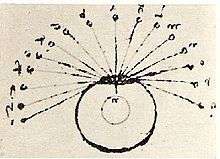Foveal

The foveal system of the human eye is the only part of the retina that permits 100% visual acuity. The line of sight is a virtual line connecting the fovea with a fixation point in the outside world.
The discovery of the line-of-sight is attributed to Leonardo da Vinci.[1]
His main experimental finding was that there is only a distinct and clear vision at the line-of-sight, the optical line that ends at the fovea. Although he did not use these words literally he actually is the father of the modern distinction between foveal vision (a more precise term for central vision) and peripheral vision.

Leonardo da Vinci, (1452–1519) was the first person known in Europe to recognize the special optical qualities of the eye. He derived his insights partly through introspection but mainly through a process that could be described as optical modelling. Based on dissection of the human eye he made experiments with water-filled crystal balls. He wrote "The function of the human eye, ... was described by a large number of authors in a certain way. But I found it to be completely different."
The modern diagram to the right shows that the fovea is a sort of pit. The Latin word fovea means pitfall.
References
- ↑ Leona da Vinci (1955), das Lebensbild eines Genies, Emil Vollmer Verlag, Wiesbaden Berlin. Dokumentation der DAVINCI Ausstellung in Mailand 1938, p. 430; cited in 'Hans-Werner Hunziker, (2006) Im Auge des Lesers: foveale und periphere Wahrnehmung – vom Buchstabieren zur Lesefreude' [In the eye of the reader: foveal and peripheral perception – from letter recognition to the joy of reading] Transmedia Stäubli Verlag Zürich 2006 ISBN 978-3-7266-0068-6